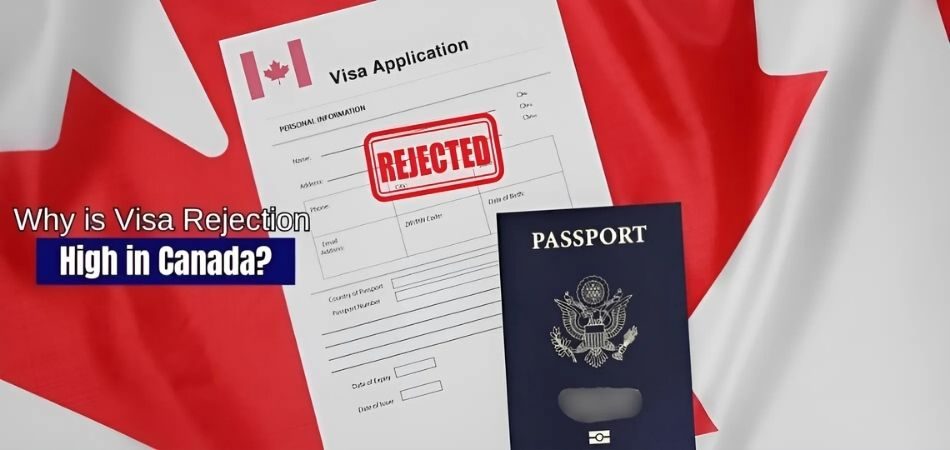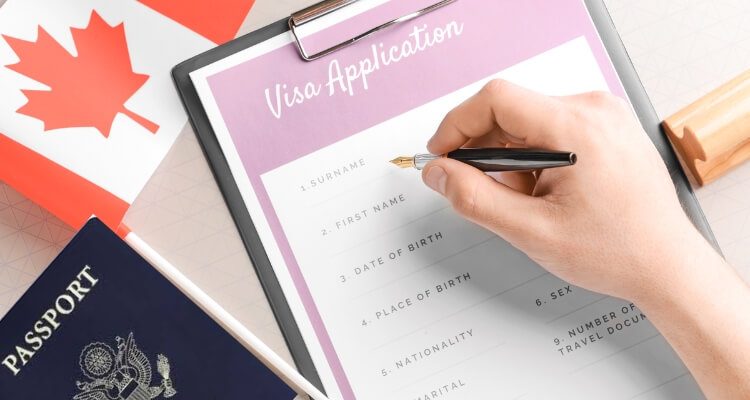Visa rejection is a significant hurdle for many individuals looking to travel or study in Canada. It can disrupt plans and lead to uncertainty, often leaving applicants wondering about the reasons behind the decision. This brings up an important question: “Why is visa rejection high in Canada?”
Several factors contribute to the high rejection rates in Canada, including stringent immigration policies, insufficient documentation, and concerns about applicants overstaying their visas. Additionally, misunderstandings regarding application requirements can lead to incomplete submissions. These elements create a complex environment for applicants, increasing the chances of rejection when they fail to meet the necessary criteria.
If you’re curious about the specific reasons behind these trends and how they may affect your application, continue reading this article. You’ll find detailed insights and information to guide you through the process effectively.
Understanding Visa Rejections: An Overview
Facing a visa rejection can be difficult for applicants, often leading to lost opportunities and disrupted travel arrangements. Several reasons may contribute to such rejections, including inadequate documentation, not meeting eligibility criteria, or ambiguous intentions. Recognizing these factors is crucial to prevent similar problems in the future.
When applying for a visa, it’s crucial to be well-prepared and aware of the specific requirements for the visa type. Those attending a Canada conference with invitation letter need to ensure that their application aligns with the criteria outlined for that visa type. Double-checking all documents before submission can prevent this.
A rejection doesn’t always mean an applicant cannot reapply. Depending on the reason for the refusal, addressing the identified issues and submitting a more complete application can lead to success on subsequent attempts. It’s key to understanding the process and how to improve your submission.
Why is Visa Rejection High in Canada?
The increasing visa rejection rates in Canada have raised concerns among many applicants. A range of factors drives this trend, making it vital for anyone looking to enter the country to grasp these reasons. Here are some crucial aspects that clarify why rejection rates are so high.

Stringent Immigration Policies
Canada has established strict immigration policies aimed at ensuring that only eligible applicants are granted visas. These policies often require comprehensive documentation, financial stability, and clear intentions for travel. Applicants must meet these strict criteria, which can lead to higher rejection rates if they fail to do so.
Insufficient Documentation
One of the leading causes of visa rejection in Canada is insufficient or inaccurate documentation. Applicants must provide all necessary paperwork, including proof of financial resources, accommodation, and travel plans. Failing to include any required documents can significantly increase the likelihood of rejection.
Concerns About Overstaying
Canadian authorities are particularly vigilant about the risk of applicants overstaying their visas. If an applicant cannot demonstrate strong ties to their home country, such as employment or family, it may raise red flags. This concern contributes to a cautious approach to processing visa applications.
Misunderstanding the Reasons
In some cases, applicants may face confusion about the difference between refused and rejected conference visas. A rejected visa means the application wasn’t accepted due to errors or missing information, while a refused visa indicates a denial after review. This misunderstanding can lead to frustration and limit future applications if the specific reasons for rejection are not addressed.
Economic Factors
Visa rejection rates can also be influenced by the prevailing economic conditions. For instance, if the applicant comes from a country facing economic instability, Canadian officials may view their application with suspicion. Financial capability is crucial, and any doubts can lead to a higher chance of rejection.
Increased Scrutiny of Applications
In recent years, there has been increased scrutiny of visa applications due to concerns about fraud and misuse of the visa system. This heightened awareness means that even minor discrepancies can result in rejections, making it essential for applicants to present clear and accurate information.
Consequences of Previous Rejections
Having a history of previous visa rejections can negatively impact future applications. Canadian immigration authorities may interpret past refusals as a sign of risk, leading to additional scrutiny. Applicants must carefully review their previous applications and address any past issues to improve their chances.
Recognizing the elements that lead to high visa rejection rates in Canada enables applicants to prepare more efficiently. By ensuring proper documentation, demonstrating financial stability, and familiarizing themselves with specific requirements, individuals can improve their chances of obtaining a successful visa approval.
What to Do if Your Canadian Visa is Rejected?
Receiving a rejection for a Canadian visa can be frustrating and disheartening. However, it is essential to stay calm and take the right steps to address the situation. Knowing what actions to take can significantly improve your chances in the future.
Review the Rejection Notice
The first step after a visa rejection is to carefully review the notice provided by the immigration authority. This document outlines the reasons for the rejection, giving you specific points to address. Understanding these reasons is crucial for preparing a more robust application in the future.
Gather Additional Documentation
Once you have identified the reasons for the rejection, it’s important to gather any additional documentation required to address those concerns. This might include financial statements, letters of invitation, or any other relevant paperwork that supports your application. Ensure that all documents are accurate and complete.
Consider Reapplying
After addressing the issues outlined in your rejection notice, you can consider reapplying for a visa. When reapplying, ensure that your new application is detailed and includes all the necessary documents. Taking the time to strengthen your application can make a significant difference.
Seek Professional Assistance
If the process feels difficult, seeking help from a visa consultant or immigration lawyer can be beneficial. Professionals can provide valuable insights and assistance in navigating the application process. They can help you understand your options and improve your chances of approval.
Understand Financial Implications
It is also essential to understand the financial implications of a visa rejection. For instance, applicants should understand the refund policy for denied Canadian conference visas. Knowing whether you can recover any fees paid can help you manage your finances effectively during this process.
Taking these steps can help you effectively address the challenges posed by a visa rejection. By reviewing the notice, gathering documentation, and possibly seeking professional help, you can improve your chances of a successful outcome in your next application.
How to Prepare for a Successful Visa Reapplication to Canada?
The process of reapplying for a Canadian visa after a rejection can be daunting, but a methodical approach can significantly enhance your chances of approval. By focusing on particular aspects and preparing diligently, applicants can bolster their applications and present a more persuasive case upon reapplication. Here’s a step-by-step guide to effectively navigate this process.
Step 1. Assess Changes in Visa Requirements
Visa requirements can change over time, and it’s crucial to ensure your reapplication aligns with the most current regulations. Review any updates to the criteria, processes, or documentation for your visa category. This helps avoid unnecessary mistakes and keeps your reapplication compliant.
Step 2. Clarify Travel Intentions
Clear and precise travel intentions are essential for visa approval. When reapplying, make sure to include detailed explanations about the purpose of your visit and why attending your planned conference or event in Canada is necessary. Presenting well-defined reasons can help avoid misunderstandings.
Step 3. Strengthen Your Supporting Documents
Ensure that all your supporting documents are in order and reflect your updated situation. Adding new documents, such as professional or personal references, can help demonstrate your commitment to your planned trip. Ensure that these documents align with your visa category’s specific requirements.
Step 4. Address Any Previous Gaps
Identify and address any gaps or weaknesses in your original application. Whether it’s providing additional financial proof or clarifying your travel history, revisiting previous issues with more substantial evidence can be the difference between rejection and approval this time around.
Step 5. Confirm Accommodation and Travel Plans
Having a solid plan for your stay in Canada shows preparedness and stability. When reapplying, provide detailed information about your accommodation and travel itinerary, ensuring every aspect of your trip is covered. This will demonstrate your seriousness about the visit.
Step 6. Improve Communication with Embassy
Establish clear and effective communication with the embassy or consulate handling your application. Reach out if necessary to clarify any concerns and ensure your paperwork is complete. Good communication shows professionalism and dedication to the visa process.
Adopting a detailed reapplication strategy can significantly improve your likelihood of obtaining a visa approval. By reinforcing your documentation, clearly articulating your travel intentions, and adhering to essential steps, you can make a persuasive case for your reapplication.
Tips for Dealing with Canada’s Visa Application System
Managing the Canada’s visa application system can be complex and difficult. However, having the right strategies can make the process smoother and increase your chances of success. Here are some essential tips to help you manage your application effectively.
- Ensure that you thoroughly read and understand the specific visa requirements before starting your application. Each visa type has different criteria, and meeting these is essential for approval.
- Prepare all the necessary documentation in advance. Having your documents organized and ready for submission will help avoid delays and ensure that your application is complete.
- Double-check your application for accuracy. Any errors or inconsistencies in your information can lead to delays or rejection. Take your time to review everything carefully.
- Use official resources to gather information about the visa application process. The Government of Canada’s website is a reliable source for up-to-date guidelines and procedures.
- Consider seeking professional help if you feel overwhelmed. Immigration consultants or lawyers can provide valuable insights and assistance, helping you navigate the application process with confidence.
- Be prepared for possible interviews. Some visa applications may require an interview, so practice answering common questions and presenting your case clearly.
- Keep track of your application status regularly. Staying informed about your application progress can help you respond quickly to any requests for additional information from the immigration authorities.
Following these tips can help you understand Canada’s visa application system more effectively. Being well-prepared and informed will enhance your chances of a successful outcome.
Frequently Asked Questions
Guiding the visa application process can be challenging, especially with the rising rates of visa rejections in Canada. Below are some frequently asked questions that address the concerns and complexities surrounding this issue. These insights can help applicants understand the situation better.
What Are Common Misconceptions About Visa Rejections in Canada?
Many applicants believe that rejections are primarily due to personal issues or character flaws, but this is often not the case. Common misconceptions include thinking that a single error in documentation is the only reason for rejection. In reality, multiple factors can contribute, including economic stability in the applicant’s home country or the specific details of the visa application.
How Do Immigration Policies Impact Visa Rejections?
Canada’s immigration policies are designed to ensure that only qualified individuals are granted visas. These policies are stringent and require applicants to meet various criteria, including financial stability and a clear intention to return home. As policies change, applicants may find it increasingly challenging to meet the necessary requirements, leading to higher rejection rates.
Can Previous Rejections Affect Future Applications?
Yes, having a history of previous visa rejections can negatively influence future applications. Immigration authorities often view past rejections as red flags, leading to increased scrutiny of subsequent applications. It’s essential for applicants to carefully address any issues with previous submissions to improve their chances of success.
What Role Does Economic Stability Play in Visa Approval?
The economic stability of an applicant’s home country significantly impacts visa approval. Canadian immigration officials often approach applications from nations facing economic difficulties with caution. This can increase if the applicant is unable to show adequate financial resources to sustain themselves during their time in Canada.
How Can Applicants Improve Their Chances of Approval?
To increase their chances of visa approval, applicants should ensure that they provide accurate and complete documentation. Being well-prepared, understanding the specific requirements for their visa type, and presenting a clear purpose for their visit can significantly increase the likelihood of a successful application.
End Note
Understanding the factors contributing to the high rates of visa rejection is crucial for anyone planning to apply to Canada. A combination of strict immigration policies, economic concerns, and documentation issues leads to a higher likelihood of rejection. The answer to “Why is visa rejection high in Canada?” lies in these complex, interrelated factors that applicants must consider seriously.
Careful preparation is key to increasing your chances of success. Make sure to double-check all documents and clearly express your travel intentions. Additionally, seeking professional help can be quite beneficial. Wishing you the best on your way to securing a Canadian visa!







